Fyodor Dostoevsky’s Bobok and Philip K. Dick’s Ubik: The Mystique of Otherness
DOI:
https://doi.org/10.15826/qr.2021.2.593Keywords:
F. M. Dostoevsky, P. K. Dick, problems of minor eschatology, Bobok, Ubik, E. Swedenborg, The Tibetan Book of the DeadAbstract
This article presents a comparative analysis of non-traditional images of otherness described by F. M. Dostoevsky in his short story Bobok (1873) and P. K. Dick in the novel Ubik (1969). With an interval of a century, the two works, Russian and American, describe the state of so-called “half-life” granted to people after their death before the final transition of the soul to the transcendent world. This state lasts from six months to two years, an artistic fiction where the writers demonstrate that their characters have lost their national eschatological traditions and their souls are filled with a moral vacuum as a result of the lost opportunity to correct their lives through “mortal memory”. Thus, their lives may be called “lives by inertia”. The article describes the theosophical influence of Heaven and Hell, a mystical work by E. Swedenborg, and The Tibetan Book of the Dead on the thanatological concepts of the works.
References
Bedina, N. N. (2020). Eskhatologicheskii khronotop srednevekovoi russkoi kul’tury v sluzhebnykh i povestvovatel’nykh knizhnykh tekstakh [The Eschatological Chronotope of Medieval Russian Culture in Service and Narrative Book Texts]. Dis. … dokt. kul‘turologii. Arkhangel‘sk, S. n. 335 p.
Butler, A. M. (1995). Ontology and Ethics in the Writings of Philip K Dick. Thesis Submitted for the Degree of PhD. S. l., Univ. of Hull. IX, 304 p.
Dergacheva, I. V. (2004). Posmertnaya sud’ba i “inoi mir” v drevnerusskoi knizhnosti [Posthumous Fate and the “Other World” in Ancient Russian Book Culture]. Moscow, Krug”. 352 p.
Dergacheva, I. V. (2011). Drevnerusskii Sinodik: issledovaniya i teksty [Old Russian Sinodik: Research and Texts]. Moscow, Krug”. 404 p.
Dick, P. K. (1992). Ubik [Ubik] / transl. by A. Lazarchuk. St Petersburg, Terra fantastica. 314 p.
Dick, P. K. (2016). Ubik. 130 p. In PDF Drive [website]. URL: https://www.pdfdrive.com/ubik-e157096857.html (accessed: 27.02.2020).
Dostoevsky, F. M. (1980). Polnoe sobranie sochinenii v 30 t. [Complete Works. 30 Vols.]. Leningrad, Nauka. Vol. 21. Dnevnik pisatelya, 1873; Stat’i i zametki, 1873‒1878. 552 p.
John the Evangelist. (1983). Ot Ioanna Svyatoe Blagovestvovanie [The Holy Gospel of John]. In Bibliya. Knigi Svyashchennogo Pisaniya. Moscow, Izdatel’stvo Moskovskoi patriarkhii, pp. 1127–1160.
Mil’kov, V. V. (1999). Drevnerusskie apokrify [Old Russian Apocrypha]. St Petersburg, Izdatel’stvo Russkogo khristianskogo gumanitarnogo instituta. 896 p.
Nikulin, N. I. (2003). “Bordo Todol’” kak pamyatnik buddiiskoi literatury [Bardo Thodol as a Monument of Buddhist Literature]. In Buddizm i literatura. Moscow, Institut mirovoi literatury RAN, pp. 112–136.
Platt, Ch. (1980). Philip K. Dick. In Dream Makers: The Uncommon People Who Write Science Fiction. Interviews by Ch. Platt. N. Y., Berkley Books. 286 p.
Platt, Ch. (1992). Philip K. Dick. Prilozhenie [Philip K. Dick. Appendix] / transl. by A. Chertkov. In Dick, Ph. K. Ubik / transl. by A. Lazarchuk. St Petersburg, Terra fantastica, pp. 288–315.
Plotnikova, A. A. (1996). Boby, fasol’ i gorokh v simvolike rozhdeniya i smerti [Beans, Haricots, and Peas in the Symbolism of Birth and Death]. In Kodovi slovenskikh kultura. Book 1. Beograd, Clio, pp. 47–55.
Swedenborg, E. (1863). O Nebesakh, o mire dukhov i ob ade [Heaven and Hell]. Leipzig, Frants. Vagner, Tipografiya Bera i Germanna. XLII, [2], 530 p.
Tikhomirov, B. N. (2016). Dostoevskii i traktat E. Svedenborga “O nebesakh, o mire dukhov i ob ade” [Dostoevsky and E. Swedenborg’s Heaven and Hell Treatise]. In Neizvestnyi Dostoevskii. No. 3, pp. 92–127. DOI 10.15393/j10.art.2016.2801.










